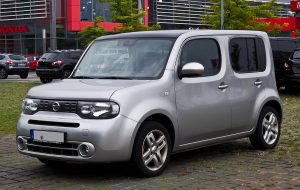Now, that’s thinking out of the box.
Nissan Canada staged the biggest giveaway in automotive history on a balmy evening in late June when it handed 50 of its brand-new boxy Cube cars (worth more than $850,000) to contest winners across Canada through presentations simulcast in Toronto, Montréal and Vancouver.
Didn’t hear about the promotion?
No surprises there since Nissan – in partnership with Toronto agency Capital C Communications – avoided the usual mainstream quadrangle of TV, radio, print and billboard to trumpet their car launch.
Instead, the automaker and its agency embarked on in mid-March on its Hypercube social media marketing campaign, that the company says offers significant rewards “creativity in Canada.”
“The creative class is what’s motivating everything these days,” explains Jeff Parent, Nissan Canada’s vice-president of sales and marketing.
“If you want to get something started, they’re the ones who are talking to each other.
“They are the ones that other people coalesce around. Creative people make their art to infect others. For us, it was a natural fit.”
With a recent Ipsos Reid poll estimating that 56 per cent of Canadians boast some sort of social networking profile, it’s no wonder that Nissan and the rest of the auto industry – including recent network campaigners Ford and Honda – are shifting some of their advertising dollars away from traditional avenues.
And they’re not the only industry following the trend.
Vacation vendor Sunquest Canada recently concluded its own series of online-driven contests to attract eyeballs to its MySpace, Facebook and Twitter sites.
Youth-driven products such as music, sneakers and snowboards have also been successfully marketed this way, advertising industry executives point out.
“This really portends the rise of the niches,” notes Ben McConnell, co-author of the books Creating Customer Evangelists and Citizen Marketers.
“The niches are really where the big manufacturers especially have to focus their efforts now – that’s where the growth industries are. You exploit the niche and hope it turns into a bigger audience along the way.”
McConnell says by targeting specific consumers via social networks, corporations can trigger powerful word-of-mouth buzz about their products.
“When you find those core early adopters, those people who love something that’s cool and new and are influential to a larger group outside themselves.
“That’s not only how word-of-mouth spreads.
“But it is how trends are formed as well,” he says.
“Finding that core group of people is always the hardest part.”
Once you find them, you have to involve them, notes Rob Young, vice-president of PHD Canada, a media and communications agency based in Toronto and Montréal
“What you’re seeing is something called ‘activation,’ which has become popular in the last five years,” Young explains.
“Giving away 50 Cubes is an example of social activation: This is where you try to take your brand down to the street level and force some sort of direct interaction between the customer and the brand.”
There was interaction aplenty at the Cube contest. Five hundred finalists, including Juno Award-winning recording artist Greg Sczebel, were assigned a blank webpage on Nissan’s hypercube.ca website and invited to creatively “audition” for their chance to win a free vehicle.
“I was fascinated how people embraced this brand and did stuff so much more creative than we could have as an agency,” said Capital C chief executive Tony Chapman, who estimates that five million potential consumers were “touched” by the three-month campaign.
“We had songwriters, dancers, poets and puppeteers – stuff that was so insanely brilliant, refreshing and original.”
Sczebel wrote two songs, submitted a video for each, and – like all contestants – was allowed to rally votes from his online community.
“I really tapped into my fan and friend base on MySpace, Facebook and Twitter,” says Sczebel, who leveraged free autographed copies of his pending October album Love And The Lack Thereof to attract supporters.
Sczebel ended up generating more than 4,000 votes and 21,000 profile views. “That’s pretty good exposure,” he admits.
“That wasn’t just my mom and my grandmother voting for me – that was a lot of people I didn’t ask to check it out.”
PHD’s Rob Young says a successful social media campaign allocates advertising dollars efficiently.
“The thinking here is that you could spend $5 to reach 1,000 people in a TV commercial at a relatively low level of involvement, or spend $5 reaching 10 people at a high level of involvement. The high level of involvement – if you get the right consumers – is a better payback.”
Unsuccessful campaigns can be catastrophic.
“It has to be done carefully and with the greatest sincerity,” Young warns.
“If it’s done poorly, then the consumer could build up a pretty harsh sense of cynicism towards the brand, and things can backfire.”
Good campaigns can also save money.
Although Parent wouldn’t divulge the cost of the multi-million-dollar campaign, he said Nissan Canada spent “a third of the amount of what I would normally spend on a car launch of this kind.”
He says it’s important to open up a dialogue with the consumer.
“We think we control the brand, but with the Internet, social media and the way people talk today, we don’t anymore,” says Parent.
“The brand is really what other people think and say about us.
“So, we’re going to ask this community, `what do you want to do next? This is your car, your brand.’ It will inform everything we do in traditional car launches for a long time.”
Ben McConnell says social media marketing campaigns are the wave of the future.
“Programs like this will probably continue to grow for not only car manufacturers, but companies of all shapes and sizes,” he says.

